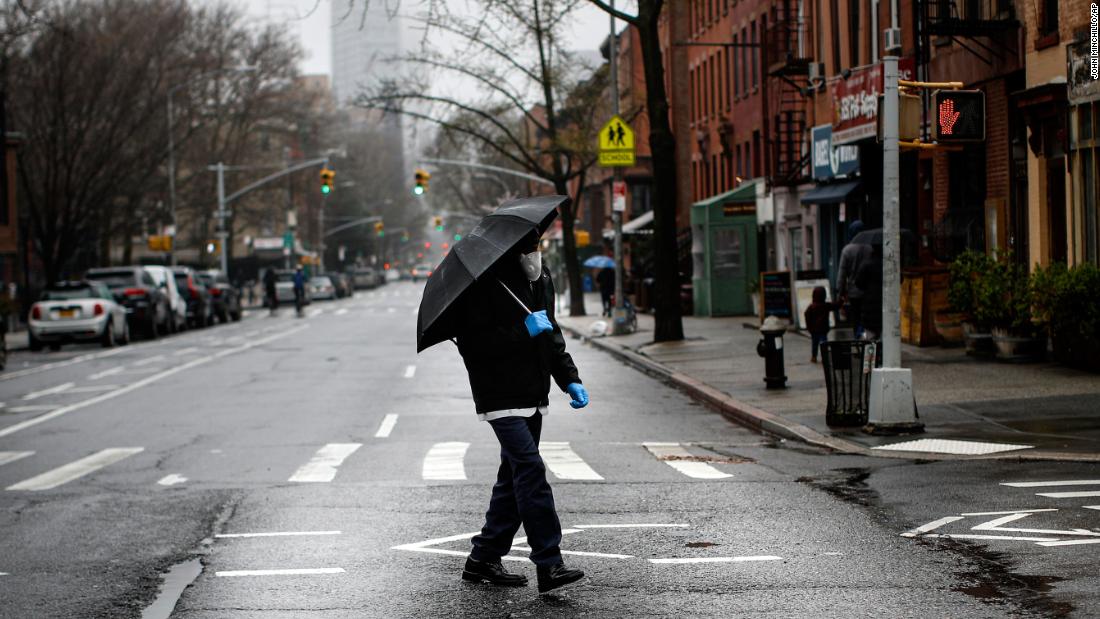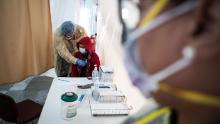[ad_1]
Each day sees more reports of deaths than the previous day. There were more than 500 reports of deaths from coronavirus on Monday, the most death reports in a single day in the United States.
More than one out of every six US deaths reported during the coronavirus crisis was reported Monday.
Hundreds of medical workers across the country have fallen sick and hospitals face dire shortages of protective gear.
“We are slowly descending into chaos,” a trauma physician at Miami’s Jackson Memorial Hospital said.
The doctor’s colleagues who normally rely on literature, research and training are “flying blind” without instruments and building guidelines from the ground up, the physician said.
And when they’re done treating coronavirus patients in trauma, they head back to the ICU to treat more.
At a New York hospital, staff members were wiping down and reusing single-use protective equipment, a doctor in the anesthesiology department said.
When the hospital ran out of life-saving ventilators, it started using anesthesia machines instead.
“There is not enough of anything,” the doctor said. “There are just so many patients who are so sick, it seems impossible to keep up with the demand.”
And it’s not just the elderly who get severe complications. More young adults are getting hospitalized with coronavirus.
At NYU-Langone Brooklyn hospital, patients ranging from their 20s to their 90s are being intubated, an emergency room nurse said.
In Boston, “we are seeing lots of young people get very sick in our intensive care units,” said Dr. Rochelle Walensky, chief of infectious disease at Massachusetts General Hospital.
“So when we are asking you to stay home, we are saying please stay home because we don’t know who they will be,” she said. “We have no way to predict who of the younger will get sicker.”
Social distancing paying off in Washington, studies say
Social distancing measures appear to be helping to slow the spread of Covid-19 in King County, Washington, according to a blog post from the public health department of Seattle & King County, which cited two reports by an institute that specializes in studying disease transmission dynamics.
“We are looking at reductions in person-to-person contact that have progressively improved and have led us to a point where we are making a very positive impact,” said Dr. Jeff Duchin, the public health officer for Seattle and King County.
The studies run by the Institute for Disease Modeling looked at data from the Washington State Department of Health and Facebook, the blog post explained.
They looked at population mobility and whether changes in that could be related to reductions in Covid-19 transmission, Dr. Daniel Klein, who led the analysis, told reporters.
The studies show that the “effective reproductive number,” roughly the average number of new transmissions from each infected person, dropped by about half from about 2.7 in late February to roughly 1.4 on March 18 in King County, Klein said.
Staying in place can save millions, top doctor says
The latest projections on coronavirus in the US were so alarming, there was virtually no choice but to extend social distancing guidelines, two of the nation’s top infectious disease experts said.
That means all Americans should avoid groups of 10 or more people, avoid discretionary travel, and consider canceling all social visits in homes. Older residents should stay home.
But even with continued social distancing, “I wouldn’t be surprised if we saw 100,000 deaths,” said Dr. Anthony Fauci, director of the National Institute of Allergy and Infectious Diseases.
“It was patently obvious, looking at the data … if we try to push back (on social distancing) prematurely, not only do we lose lives, but it probably would even hurt the economy,” he said.
“So you would lose on double accounts. So to us, it was no question what the right choice was.”
“If we do things together well, almost perfectly, we could get in the range of 100,000 to 200,000 fatalities,” Birx told NBC’s “Today” show Monday. “We don’t even want to see that.”
Birx said the worst-case projections show “between 1.6 million and 2.2 million deaths if you do nothing” and disregard social distancing guidelines.
‘Those are tinders that can turn into big fires’
Places with few cases can also steer the direction of this outbreak, Fauci said.
“If you just look at those (places) and say, ‘There are very little infections in this area or that area, we don’t have to worry about it,’ you’re making a big mistake. Because those are tinders that can turn into big fires.”
“You’ve got to look at those other areas and make sure you very vigorously identify, test … get individuals who you take out of society because they’re isolated, and do contact tracing,” he said.
FDA approves limited emergency use of treatments
But over the weekend, the US Food and Drug Administration issued an emergency use authorization for chloroquine, a drug commonly used against malaria, and hydroxychloroquine to use on patients hospitalized with coronavirus.
Though evidence is limited on the efficacy of chloroquine and hydroxychloroquine, the FDA said the drugs’ benefits outweighed their risk.
“Based on the totality of scientific evidence available to FDA, it is reasonable to believe that chloroquine phosphate and hydroxychloroquine sulfate may be effective in treating COVID-19,” said the agency in its letter.
Treatment authorization is limited to patients who are currently hospitalized and weigh at least 110 pounds. Health care providers must contact their local or state health departments to access the drugs.
A new travel advisory would limit domestic travel
The states would have “full discretion” on implementing the advisory, which exempts employees in working in critical fields.
The CDC advisory came as some states started implementing their own rules on visitors coming from out-of-state hotspots.
In Delaware, Gov. John Carney modified his state of emergency declaration to require out-of-state travelers to self-quarantine for two weeks.
And in Texas, Gov. Greg Abbott of Texas expanded the state’s rules on which visitors must self-quarantine for 14 days.
Previously, anyone flying into Texas from New York, New Jersey, Connecticut and New Orleans must quarantine 14 days.
The expanded order adds anyone driving into Texas from Louisiana plus anyone flying from Miami, Detroit, Chicago, Atlanta, Washington state and California.
CNN’s Arman Azad, Jacqueline Howard, Dakin Andone, Laura Ly, Kristina Sgueglia and Betsy Klein contributed to this report.
[ad_2]
Source link








